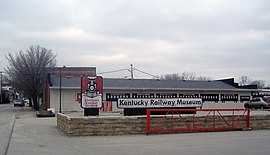Kentucky Railway Museum

Entrance to the museum facility
|
|
| Established | 1954 |
|---|---|
| Location | New Haven, Kentucky, United States |
| Coordinates | 37°39′18″N 85°35′28″W / 37.655°N 85.591°W |
| Type | Railroad |
| Website | http://www.kyrail.org/ |
The Kentucky Railway Museum, now located in New Haven, Kentucky, United States, is a non-profit railroad museum dedicated to educating the public regarding the history and heritage of Kentucky's railroads and the people who built them. Originally created in 1954 in Louisville, Kentucky, the museum is at its third location, in extreme southern Nelson County. It is one of the oldest railroad stations in the United States.
The museum owns four steam locomotives, six diesel locomotives and over a hundred pieces of rolling stock. Four of the pieces are separately on the National Register of Historic Places: the Louisville and Nashville Steam Locomotive No. 152, the Louisville and Nashville Combine Car Number 665, the Mt. Broderick Pullman Lounge-Obs-Sleeping Car, and the Frankfort and Cincinnati Model 55 Rail Car.
The site of the current museum was built by the Louisville and Nashville Railroad from 1856 to 1857, on their old line, which ran to Lebanon, Kentucky. The line was of vital importance to the Union cause, making it a frequent target of Confederate forces under John Hunt Morgan, and others, during the 1860s; the nearby bridge was even destroyed. The railroad station on the site now is a 1990s replica of the station which was built at the site in 1910.
The museum was chartered in 1954 by railroad enthusiasts from Louisville, through the Kentucky General Assembly, who wished to preserve steam locomotives and other rail paraphernalia. One of its very first displays was the Louisville and Nashville #152 locomotive, a caboose, and a wooden coach. These first donations, including railroad track, were from the Monon Railroad, and the Louisville and Nashville Railroad. The museum has moved twice since it was chartered, from its original location in Louisville. The first site was at 1837 East River Road, where the Louisville Soccer Fields are now located. This first location was 6 acres (2.4 ha) in size, and was fenced and lighted by the Louisville Parks Department. The site opened for the public on May 30, 1958, with its dedication taking place on September 30, 1957. The museum eventually left the first location because of flooding from the nearby Ohio River, and a general lack of necessary space. The worst of these floods was in March 1964.
...
Wikipedia
